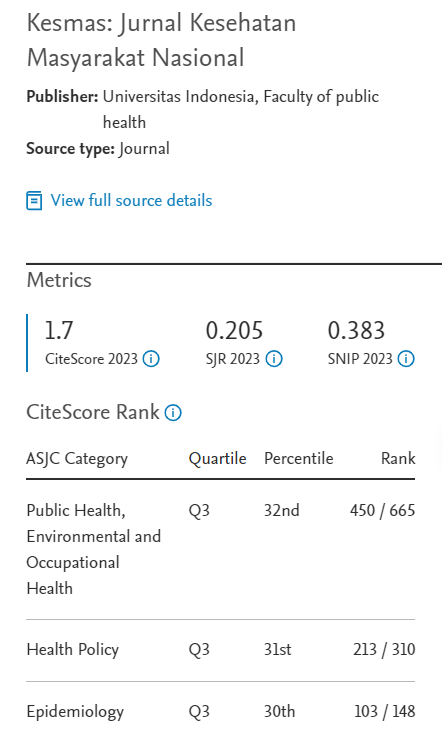Abstract
Anak penderita Human Immunodeficiency Virus/Acquired Immune Deficiency Syndrome (HIV/AIDS) di Indonesia memperlihatkan tren yang semakin meningkat karena meningkatnya proporsi perempuan terinfeksi HIV/AIDS. Pertimbangan pada dampak besar yang dihadapi anak penderita HIV mendorong kebutuhan pengembangan instrumen khusus untuk mengukur kualitas hidup mereka. Penelitian ini bertujuan mengembangkan instrumen kualitas hidup anak penderita AIDS dengan memodifikasi instrumen yang ada sesuai dengan konteks Indonesia. Pada penelitian ini ditemukan hasil bahwa instrumen yang dikembangkan mempunyai reliabilitas yang cukup baik pada balita dan anak usia 5 – 11 tahun. Nilai reliabilitas (Cronbach’s Alpha) balita, domain fungsi fisik, fungsi sosial, dan gejala HIV masing masing adalah 0,71; 0,72; dan 0,88, sedangkan pada anak 5 – 11 tahun, domain fungsi-fungsi fisik, psikologis, sosial, sekolah, dan gejala terkait HIV masing-masing 0,76; 0,89; 0,67; 0,67; dan 0,88. Penelitian ini menunjukkan untuk konteks Indonesia, nilai ambang batas CD4 yang menunjukkan perbedaan kualitas hidup adalah 15%. Pada balita, dari berbagai ketiga domain, hanya domain gejala terkait HIV yang cukup sensitif untuk mendeteksi perbedaan kualitas hidup anak, sementara pada anak 5 – 11 hanya domain fungsi fisik dan fungsi psikologis yang cukup sensitif untuk mendeteksi perbedaan kualitas hidup anak. Penelitian ini menunjukkan bahwa dampak HIV pada anak masih terkonsentrasi pada gangguan fungsi fisik, fungsi psikologis, dan gejala terkait HIV.
Children with HIV/AIDS in Indonesia are increasing due to the increase of woman with HIV. A special instrument for measuring quality of life (QoL) of children with HIV is needed to be developed as the great impact of the infection to children. This study was conducted by modifying the existing QoL instrument of children for Indonesian context. The study indicated that the reliability of the instrument is quite good both for children under 5 and 5 – 11 years old. Reliability values (Cronbach’s Alpha) for under 5, domains of physical function, social function, and HIV-related symptoms are 71, 72, and 88 respectively while for children 5 – 11 years old, domains of physical, psychological, social, and school functions, and HIV-related symptoms are 76, 89, 67, 67, and 88 respectively. The study showed, for Indonesian context, 15% of CD4 is indicated as the threshold to detect the difference of QoL for children with HIV. However, for under 5 years old, only questions of HIV-related symptoms domain which is sensitive to detect difference QoL, whereas for children of 5 – 11 years old, the questions concerning physical and psychological domains which are sensitive to detect difference QoL. The study indicated that the impact of HIV on children is mostly on physical and psychological functions and HIV-related symptoms.
References
- Kementerian Kesehatan Republik Indonesia, Direktorat Jenderal Pengendalian Penyakit dan Penyehatan Lingkungan. Laporan triwulan situasi perkembangan HIV dan AIDS di Indonesia sampai dengan maret 2010. Jakarta: Kementerian Kesehatan Republik Indonesia; 2010.
- Kementerian Kesehatan Republik Indonesia, Ditjen Pengendalian Penyakit dan Penyehatan Lingkungan. Laporan triwulan situasi perkembangan HIV dan AIDS di Indonesia sampai dengan Desember 2007. Jakarta: Kementerian Kesehatan Republik Indonesia; 2007.
- United Nations Children’s Fund. Children affected by HIV/AIDS in South Asia: a synthesis of current global, regional, and national thinking and research. Nepal: United Nations Children’s Fund; 2007 [diakses tanggal 19 Desember 2010]. Diunduh dari: http://www.unicef.org.
- United Nations Educational, Scientific, and Culture Organization. HIV/AIDS and education. 2003 [diakses tanggal 19 Desember 2010. Diunduh dari: http://www.unesco.org.
- Bomba M, Nacinovich R, Oggiano S, Cassani M, Baushi L, Bertulli C, et al. Poor health-related quality of life and abnormal psychosocial adjustment in Italian children with perinatal HIV infection receiving highly active antiretroviral treatment. AIDS Care. 2010; 22 (7); 858-65.
- Byrne MW & Honig J. Psychometrics of child health questionnaire parent short form (CHQ-28) used to measure quality of life in HIV-infected children on complex anti-retroviral therapy. Journal Quality of Life Researchi. 2005; 14: 1769-74.
- Lee GM, Gortmaker SL, McIntosh K, Huges MD, Oleske JM. Quality of life of children and adolescent: impact of HIV infection and antiretroviral treatment. Pediatrics. 2006; 117: 273-83.
- Diniz LO, Pinto JA. Quality of life of HIV-infected children in Brazil. Bol Med Hosp Infant Mex. 2009; 66: 325-34.
- Gortmaker SL, Landerking WR, Clark C, Lee S, Fowler MG, Oleske JM, The ACTG 219 Team. Development and use of pediatric quality of life questionnaire in AIDS clinical trials: reliability and validity of the general health assessment for children. In Drotar D, ed. Measuring Health-Related Quality of Life in Children and Adolescents: Implication for Research and Practice. Mahwah NJ: Lawrence Erlbaum Associates; 2001. hal. 219-35.
- Kuntawee C, Fungladda W, Kaewkungwal J, Chanthavanich P, Chotpittayasunon T. Social factors related quality of life among HIV-infected children in Ubon Ratchathani Province, Thailand. Southeast Asian Journal of Tropical Medicine and Public Health. 2010; 41 (5): 1136-44.
- Oberdorfer P, Louthrenoo O, Puthanakit T, Sirisanthana V, Sirisanthana T. Quality of life among HIV-infected children in Thailand. Journal of the International Association of Physician in AIDS Care. 2008; xx (x): 1-7.
- Punpanich W, Hays RD, Detels R, Chokephaibulkit K, Chantibuddhiwet U, Leowsrisook P, Prasitsuebsai W. Development of culturally appropriate health-related quality of life measure for human immunodeficiency virus-infected children in Thailand. Journal of Pediatrics and Child Health. 2010; 47 (1-2): 27-33.
- Muhaimin T. Mengukur kualitas hidup anak. Kesmas, Jurnal Kesehatan Masyarakat Nasional. 2010; 5 (2): 51-5.
- O’Connor R. Issues in the measurement of health-related quality of life, NHMRC national centre for health program evaluation. Melbourne, Australia; 1993.
Recommended Citation
Muhaimin T , Utomo B , Utoyo D ,
et al.
Instrumen Pengukuran Kualitas Hidup Anak Terinfeksi HIV.
Kesmas.
2011;
6(3):
-
DOI: 10.21109/kesmas.v6i3.103
Available at:
https://scholarhub.ui.ac.id/kesmas/vol6/iss3/5







